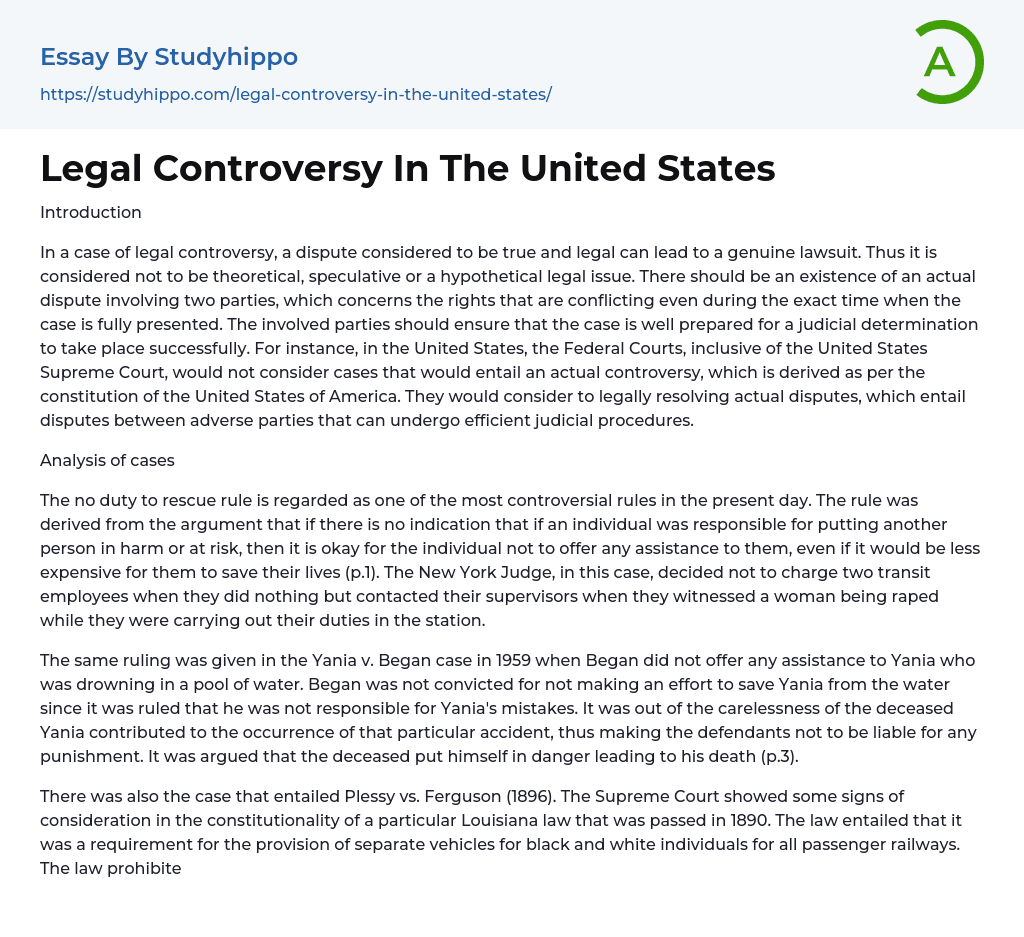Introduction
In a case of legal controversy, a dispute considered to be true and legal can lead to a genuine lawsuit. Thus it is considered not to be theoretical, speculative or a hypothetical legal issue. There should be an existence of an actual dispute involving two parties, which concerns the rights that are conflicting even during the exact time when the case is fully presented. The involved parties should ensure that the case is well prepared for a judicial determination to take place successfully.
For instance, in the United States, the Federal Courts, inclusive of the United States Supreme Court, would not consider cases that would entail an actual controversy, which is derived as per the constitution of the United States of America. They would consider to legally resolving actual disputes, wh
...ich entail disputes between adverse parties that can undergo efficient judicial procedures.
Analysis of cases
The no duty to rescue rule is regarded as one of the most controversial rules in the present day. The rule was derived from the argument that if there is no indication that if an individual was responsible for putting another person in harm or at risk, then it is okay for the individual not to offer any assistance to them, even if it would be less expensive for them to save their lives (p.1). The New York Judge, in this case, decided not to charge two transit employees when they did nothing but contacted their supervisors when they witnessed a woman being raped while they were carrying out their duties in the station.
The same ruling was given in the Yania v. Began case in 1959 when Began did not
offer any assistance to Yania who was drowning in a pool of water. Began was not convicted for not making an effort to save Yania from the water since it was ruled that he was not responsible for Yania's mistakes. It was out of the carelessness of the deceased Yania contributed to the occurrence of that particular accident, thus making the defendants not to be liable for any punishment. It was argued that the deceased put himself in danger leading to his death (p.3).
There was also the case that entailed Plessy vs. Ferguson (1896). The Supreme Court showed some signs of consideration in the constitutionality of a particular Louisiana law that was passed in 1890. The law entailed that it was a requirement for the provision of separate vehicles for black and white individuals for all passenger railways.
The law prohibited white individuals to sit in vehicles meant for the blacks, while the black individuals were not allowed to sit in vehicles meant for the whites. Once the rule was violated, railway employees and passengers would be heavily prosecuted (p.4). Homer Plessy appeared as a person with a white race although he was not white and booked a first class ticket meant for white folks. Unfortunately, he was convicted for not abiding by the rules and sent to jail. This made him petition the ruling given by the judge by arguing that the was increased stigmatization of the black individuals (p.4).
However, the Court rejected Plessy’s argument, emphasizing that resources and facilities were equally provided to both black individuals and white individuals. There was also some emphasis that the blacks and whites were equally punished in case
any of the laws were violated. Justice John Martial argued that the as per the constitution, no group of individuals is considered to be superior or dominant over other groups of individuals. During that period, there was increased racial segregation in public places.
This was until the Brown vs. Board of Education case, which led to the overturning of the separate but equal rule. The main argument during this case was that it was unethical to carry out segregation of children by race in Public Schools. It was argued that it was a violation of the fourteenth amendment. This lead to the formation of the civil rights movement by Brown, which received political, social and civil backing in ensuring there, is equality irrespective of someone race (p.5).
There was also the Roe vs. Wade case that majorly focused on abortion. Roe decided to challenge the Texas criminal abortion laws, which did not encourage abortion unless advised by the doctor to carry out the procedure for the mother’s life to be saved (p.6). Another family, referred to as the Does, also had some disagreement with the law, stating that there should be some allowance for unpreparedness for parenthood, malfunctioning when using contraceptives or impairment of wife’s health. The judge later gave the ruling that the law was indeed inconsiderable, vague and void. The state is said to entail significant interests in the protection of the woman’s health and the human life.
Thus, the law argues that a woman has got the qualified right to terminate her pregnancy, that is as per the Due Process Clause of the Fourteenth Amendment, which also ensures that there is a high level of
protection against state action and level of privacy (p.6).
Conclusion
The issue of controversy can lead to undesirable judicial decisions that may not be in favor of the complainant. It can be argued that formulated laws, regardless of what they entail, should be fully adhered so that one does not get convicted for breaking clearly stipulated laws. Additionally, it is unethical for someone not to offer assistance to an individual who is experiencing a life-threatening situation, even though he or she did not put him in that situation.
However, the legal aspect of this can be approved. Issues to do with race and abortion should also have clearly stipulated guidelines so that they can be followed and feedback can be obtained to determine the effectiveness of the laws.




